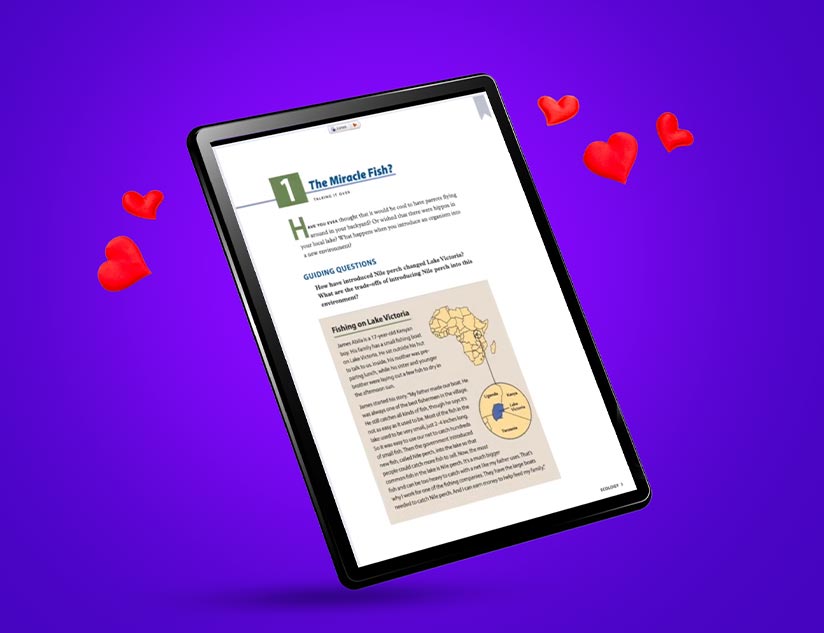The US educational market offers lucrative opportunities for growth for K-12 digital publishing houses with the country’s eBook market poised to reach $5.52 billion by 2033. However, with every school district having distinct content adoption criteria and curricula, publishers need a dynamic platform that allows them to adapt quickly. Plus, interactive eBooks, known to improve engagement and learning outcomes, is a crucial differentiator for edtech publishers looking to expand in the US market.
Interactive eBooks elevate learning outcomes with:
- Multimedia Components to Boost Engagement
Learning Impact: Enhance information comprehension and knowledge retention via relatable simulations.
- Interactive Elements to Encourage Learning Application
Learning Impact: Enrich learner experiences and bridge the gap between digital and traditional learning experiences.
Laying The Ground Work
Interactive eBooks are undoubtedly a necessity for entering the US educational market. While prioritizing the alignment of interactive learning materials with “explicitly stated learning objectives” is imperative, having the flexibility to define unique learning paths is critical to delivering personalized experiences. Plus, entering a new market can be challenging, especially in the US. Comprehensively meeting the needs of the country’s market is critical.
This is because the US Education Department has zoomed in on improving online education monitoring and pedagogy. It has even set a deadline of July 2027 for the new regulations to be fully implemented. Staying compliant and enabling extensive reporting with detailed insights is critical to getting adopted by US school districts.
While there is growing demand for K-12 digital publishing in the US, the oversight is also growing more stringent. Compliance with standards, such as WCAG (accessibility), COPPA (child online privacy), and FERPA (student data privacy), is non-negotiable. This makes instilling compliance assurance within course authoring and distribution workflows crucial. Adopting MagicBox™’s AI-powered course and assessment authoring tools expedites the publishing of interactive eBooks, while also easing compliance.
Forging a Robust Framework
Patchworking interactive features into existing eBooks may not be enough for edtech publishers. Optimizing eBooks with interactive features requires more:
Boosting Engagement with Interactive Features
- Add multimedia and gamified elements at places where they add value, and enhance conceptual understanding and skill acquisition.
- Develop modular materials that offer flexible learning path creation.
- Include hotlinks to offer additional learning support, access to further resources, and annotation facilities.
- Leverage learning analytics to enable personalization of learning journeys, catering to individual learning preferences and paces.
Localization & Accessibility
- Provide multilingual support to enable learning delivery in the preferred language, especially for younger learners.
- Adopt tools that facilitate seamless content localization and cultural sensitization.
- Ensure accessibility in areas with poor connectivity with downloadable eBooks.
- Add features, such as speech-to-text/text-to-speech and image captioning, to support learners with special needs.
Integration with US Learning Systems
- Employ APIs to ensure compatibility with existing LMSs and educational tools, such as Canvas and Moodle.
- Make navigation across learning and rostering tools effortless with single sign-on (SSO) and secure identity management.
Fortifying Security and Ensuring Growth
Unauthorized redistribution and piracy are primary concerns for the K-12 digital publishing industry. The security of digital learning platforms may not suffice to protect your intellectual property through the distribution value chain. This is where digital rights management solutions (DRMS) for eBooks prove instrumental in protecting your assets. Role and time-bound access with expiry control offer multi-faceted protection to your learning materials.
MagicBox™’s DRM solution protects interactive eBooks and other learning resources by providing protection against screengrabbing and printing by individual learners. It also enables access control via separate codes, and restricts the number of devices that can be active at any time. In addition, MagicBox™’s digital rights management solution for eBooks includes diverse sales models, such as subscription and B2B bulk-selling. These support multiple distribution and pricing strategies to drive sales and improve distribution.
Unlocking Success: Establishing a Strong Presence in the US
The key to success with learning design lies in integrating interactive elements that encourage meaningful participation. Focusing on value-additions to pedagogy rather than just cosmetic utilization of interactive features in eBooks is paramount. Plus, ensuring sustainable growth and safeguarding your valuable assets is critical to maintaining a strong foothold in the market.
Your Blueprint to Success in the US Markets
- Prioritize compliance with US educational and privacy regulations.
- Adopt course creation platforms and tools that facilitate seamless localization and ensure accessibility compliance.
- Adopt content authoring platforms that facilitate personalization through tailored interactive elements to offer greater value to learners.
- Implement strong DRM solutions to protect your intellectual property and enable effective monetization strategies.
Embracing interactive eBooks can be a game-changer for K-12 digital publishing houses looking to expand in the US and other global markets. Partnering with an award-winning edtech solutions provider for publishers with AI/ML-powered authoring and distribution tools can streamline your journey to success. Speak to the experts at MagicBox™ to capitalize on the opportunities offered by the US educational market.
















